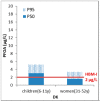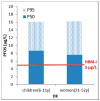Development of Policy Relevant Human Biomonitoring Indicators for Chemical Exposure in the European Population
- PMID: 30248963
- PMCID: PMC6209865
- DOI: 10.3390/ijerph15102085
Development of Policy Relevant Human Biomonitoring Indicators for Chemical Exposure in the European Population
Abstract
The European Union's 7th Environmental Action Programme (EAP) aims to assess and minimize environmental health risks from the use of hazardous chemicals by 2020. From this angle, policy questions like whether an implemented policy to reduce chemical exposure has had an effect over time, whether the health of people in specific regions or subpopulations is at risk, or whether the body burden of chemical substances (the internal exposure) varies with, for example, time, country, sex, age, or socio-economic status, need to be answered. Indicators can help to synthesize complex scientific information into a few key descriptors with the purpose of providing an answer to a non-expert audience. Human biomonitoring (HBM) indicators at the European Union (EU) level are unfortunately lacking. Within the Horizon2020 European Human Biomonitoring project HBM4EU, an approach to develop European HBM indicators was worked out. To learn from and ensure interoperability with other European indicators, 15 experts from the HBM4EU project (German Umweltbundesamt (UBA), Flemish research institute VITO, University of Antwerp, European Environment Agency (EEA)), and the World Health Organization (WHO), European Core Health Indicator initiative (ECHI), Eurostat, Swiss ETH Zurich and the Czech environmental institute CENIA, and contributed to a workshop, held in June 2017 at the EEA in Copenhagen. First, selection criteria were defined to evaluate when and if results of internal chemical exposure measured by HBM, need to be translated into a European HBM-based indicator. Two main aspects are the HBM indicator's relevance for policy, society, health, and the quality of the biomarker data (availability, comparability, ease of interpretation). Secondly, an approach for the calculation of the indicators was designed. Two types of indicators were proposed: 'sum indicators of internal exposure' derived directly from HBM biomarker concentrations and 'indicators for health risk', comparing HBM concentrations to HBM health-based guidance values (HBM HBGVs). In the latter case, both the percentage of the studied population exceeding the HBM HBGVs (PE) and the extent of exceedance (EE), calculated as the population's exposure level divided by the HBM HBGV, can be calculated. These indicators were applied to two examples of hazardous chemicals: bisphenol A (BPA) and per- and polyfluoroalkyl substances (PFASs), which both have high policy and societal relevance and for which high quality published data were available (DEMOCOPHES, Swedish monitoring campaign). European HBM indicators help to summarize internal exposure to chemical substances among the European population and communicate to what degree environmental policies are successful in keeping internal exposures sufficiently low. The main aim of HBM indicators is to allow follow-up of chemical safety in Europe.
Keywords: HBM; HBM4EU; groups of substances; health-based guidance value; human biomonitoring; indicator; science-policy translation.
Conflict of interest statement
The authors declare no conflict of interest.
Figures





References
-
- HBM4EU. [(accessed on 3 September 2018)]; Available online: https://www.hbm4eu.eu/about-hbm4eu/
-
- Ganzleben C., Antignac J.-P., Barouki R., Castaño A., Fiddicke U., Klánová J., Lebret E., Olea N., Sarigiannis D., Schoeters G.R., et al. Human biomonitoring as a tool to support chemicals regulation in the European Union. Int. J. Hyg. Environ. Health. 2017;220:94–97. doi: 10.1016/j.ijheh.2017.01.007. - DOI - PubMed
-
- Council of the European Union Outcome of the Council meeting; Proceedings of the 3512nd Council Meeting, Environment; Brussels, Belgium. 19 December 2016.
-
- EC Study for the Strategy for a Non-Toxic Environment of the 7th Environment Action Programme Final Report. [(accessed on 3 September 2018)]; Available online: http://ec.europa.eu/environment/chemicals/non-toxic/pdf/NTE%20main%20rep....
-
- EU Decision No 1386/2013/EU of the European Parliament and of the Council of 20 November 2013 on a General Union Environment Action Programme to 2020 Living Well, Within the Limits of Our Planet, OJ L 354, 20.12.2013, pp. 171–200. [(accessed on 3 September 2018)];2013 Available online: https://eur-lex.europa.eu/legal-content/EN/TXT/?uri=celex%3A32013D1386.
Publication types
MeSH terms
LinkOut - more resources
Full Text Sources
Other Literature Sources

